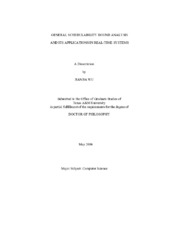| dc.description.abstract | Real-time system refers to the computing, communication, and information system with deadline requirements. To meet these deadline requirements, most systems use a mechanism known as the schedulability test which determines whether each of the admitted tasks can meet its deadline. A new task will not be admitted unless it passes the schedulability test. Schedulability tests can be either direct or indirect. The utilization based schedulability test is the most common schedulability test approach, in which a task can be admitted only if the total system utilization is lower than a pre-derived bound. While the utilization bound based schedulability test is simple and effective, it is often difficult to derive the bound. For its analytical complexity, utilization bound results are usually obtained on a case-by-case basis. In this dissertation, we develop a general framework that allows effective derivation of schedulability bounds for different workload patterns and schedulers. We introduce an analytical model that is capable of describing a wide range of tasks' and schedulers'€™ behaviors. We propose a new definition of utilization, called workload rate. While similar to utilization, workload rate enables flexible representation of different scheduling and workload scenarios and leads to uniform proof of schedulability bounds. We introduce two types of workload constraint functions, s-shaped and r-shaped, for flexible and accurate characterization of the task workloads. We derive parameterized schedulability bounds for arbitrary static priority schedulers, weighted round robin schedulers, and timed token ring schedulers. Existing utilization bounds for these schedulers are obtained from the closed-form formula by direct assignment of proper parameters. Some of these results are applied to a cluster computing environment. The results developed in this dissertation will help future schedulability bound analysis by supplying a unified modeling framework and will ease the implementation practical real-time systems by providing a set of ready to use bound results. | en |


